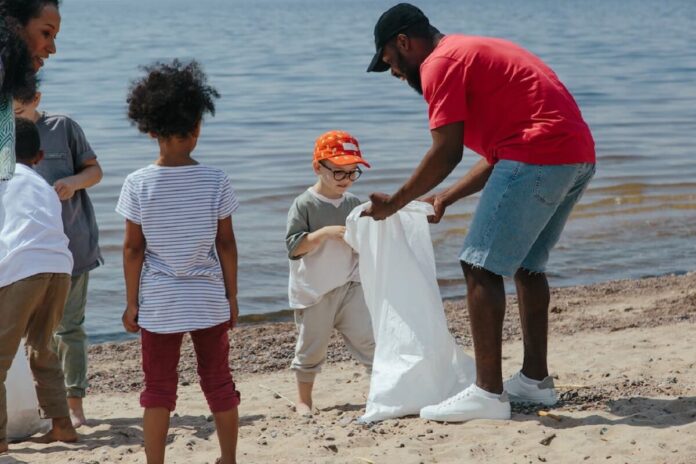You have a powerful role in shaping the future of your children. One of the most essential lessons you can impart to your children is the importance of safeguarding our precious water resources.
As a parent, you can unlock their curiosity about water pollution. This will help you instill in them a sense of responsibility for the environment. By teaching your kids about water pollution, you equip them with knowledge and nurture their connection to the world around them.
In this guide, we’ll explore engaging ways to educate your little ones about water pollution.
Learn From Past Incidents
Teaching kids about water pollution becomes more impactful when you share real-world examples that have shaped our understanding of its consequences.
One such incident is the Deepwater Horizon oil spill. Back in 2010, this massive oil spill in the Gulf of Mexico had far-reaching effects on marine life and coastal ecosystems. When you discuss this incident, you can help your kids grasp the scale of damage that pollution can cause.
Moving on to another case, the Flint Water Crisis serves as a stark reminder of the importance of safe drinking water. The presence of lead in the water supply led to severe health concerns, especially for the elders and children. This incident underscores the crucial need for proper water treatment and distribution systems. It is also a valuable lesson for kids on the importance of safeguarding water sources.
The Camp Lejeune water contamination incident highlights the potential risks associated with polluted groundwater. This incident occurred due to the presence of hazardous chemicals in the drinking water at a military base. According to TorHoerman Law, the affected individuals faced serious health conditions, including cancer, birth defects, miscarriages, etc.
After enduring prolonged hardships, the victims decided to file a Camp Lejeune contaminated water lawsuit. The victims’ determination to take this step underscores the gravity of the situation and their resolve to hold responsible parties accountable. This lawsuit signifies their pursuit of acknowledgment, compensation, and rectification for the significant challenges they faced due to the contaminated water.
Interactive Experiments
Engaging kids with interactive experiments is a powerful way to help them grasp the concept of water pollution.
Conduct a basic experiment: Take two water containers, put food coloring in one, and have your child envision the colored water as polluted. Then, have them brainstorm ways to “clean” the water using materials like filters or sponges. This hands-on activity demonstrates how pollutants can affect water and sparks their creativity in finding solutions.
Another effective experiment involves creating a mini watershed. Use a tray filled with soil and place small objects like plastic pieces on the “land.” Sprinkle water over the tray, simulating rainfall, and observe how the water carries the objects into a “river.” This demonstrates how runoff can transport pollutants from land to water bodies.
You can also explore the concept of bioindicators by setting up a mini aquatic ecosystem. Collect water from various places like a pond or stream, and let your child compare the organisms in each sample. This experiment helps them understand how the presence or absence of certain species can indicate the health of the water.
When teaching kids about water pollution, a significant lesson involves emphasizing how human activities on land affect water quality. According to the United Nations Environment Programme, nearly 80% of marine pollution finds its origins in land-based sources. This emphasizes the crucial necessity to educate children about how their daily actions could directly affect the health of water bodies.
Help Them Become Water Stewards
Empowering kids to become water stewards is a vital step in the journey to protect our planet’s water resources. Encourage your children to take small actions that collectively make a big difference.
Remind them to turn off the tap while brushing their teeth. It is a simple habit that conserves gallons of water. A study shows that turning off the faucet while brushing morning and night saves 4 to 8 gallons of water. Over the course of a month, this seemingly small action could accumulate to a total savings exceeding 200 gallons. It illustrates the substantial impact of individual efforts.
Teach your kids about responsible waste disposal. Describe that debris and garbage can make their route into aquatic environments, causing harm to underwater organisms. Organize a neighborhood cleanup to show them how taking care of our surroundings directly contributes to water protection.
When they witness the tangible results of their actions, they’ll realize that being water stewards goes beyond theoretical knowledge.
Nature’s Role in Water Protection
Understanding the integral role that nature plays in safeguarding water quality is essential for kids. Think of ecosystems like wetlands, forests, and grasslands as Earth’s own filtration systems. These natural surroundings soak up contaminants and hinder them from reaching the water sources.
Forests serve as protective barriers, which can halt soil erosion. You can take your children to a riverbank where a tree can potentially halt runoff. When they realize trees on riverbanks stop runoff, they see why protecting these areas matters. Well-maintained forested regions can contribute to lower sediment levels in rivers, promoting healthier aquatic habitats.
An article in Frontiers shows fungi’s vital role in breaking down bioplastics across ecosystems, underscoring nature’s impact on water protection. The studies have demonstrated that fungi establish colonies and break down bioplastics in terrestrial, freshwater, and marine settings.
Sharing such insights with your child can help them realize that nature has its own mechanisms to combat pollution. Human actions can either support or disrupt these processes.
Summing Up
In the journey of teaching kids about water pollution, you are nurturing a sense of responsibility and empathy for the environment. By exploring the tips mentioned here, you can sow the seeds of change in the next generation. With the knowledge and values, your children are poised to become proactive guardians of the planet’s most precious element.
Read Also: Sharksnado: The Ultimate Thrill Ride
When you instill these lessons early on, you can foster a brighter future where clean water is cherished by all. These tools and tips will serve as catalysts for positive change, guiding us toward the planet that everyone envisions.









